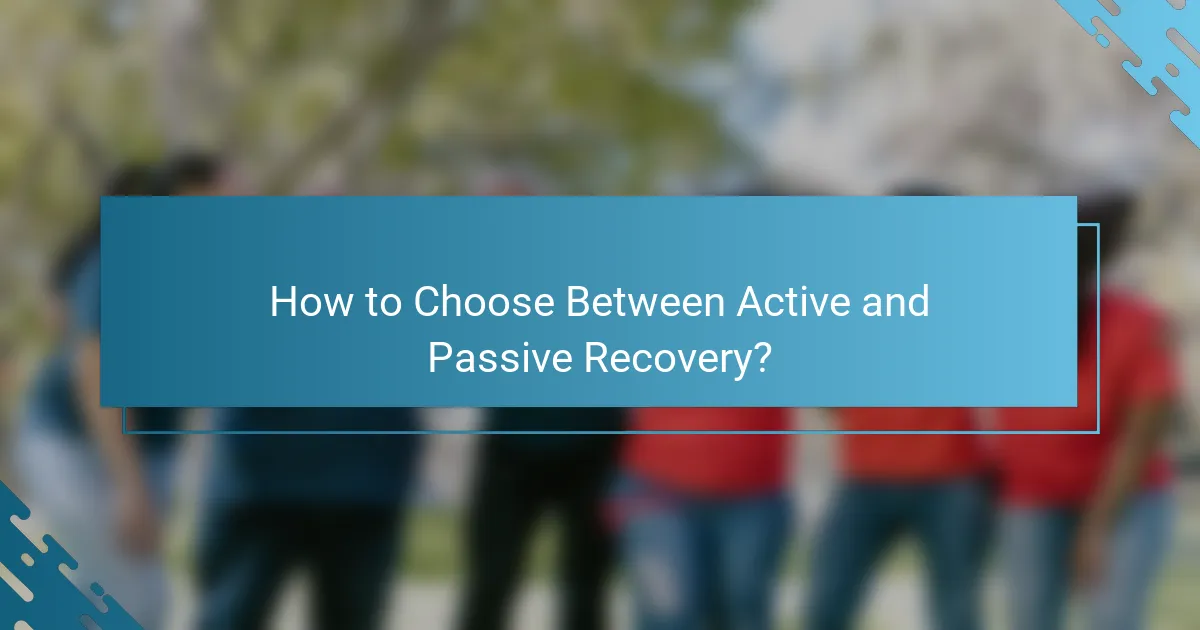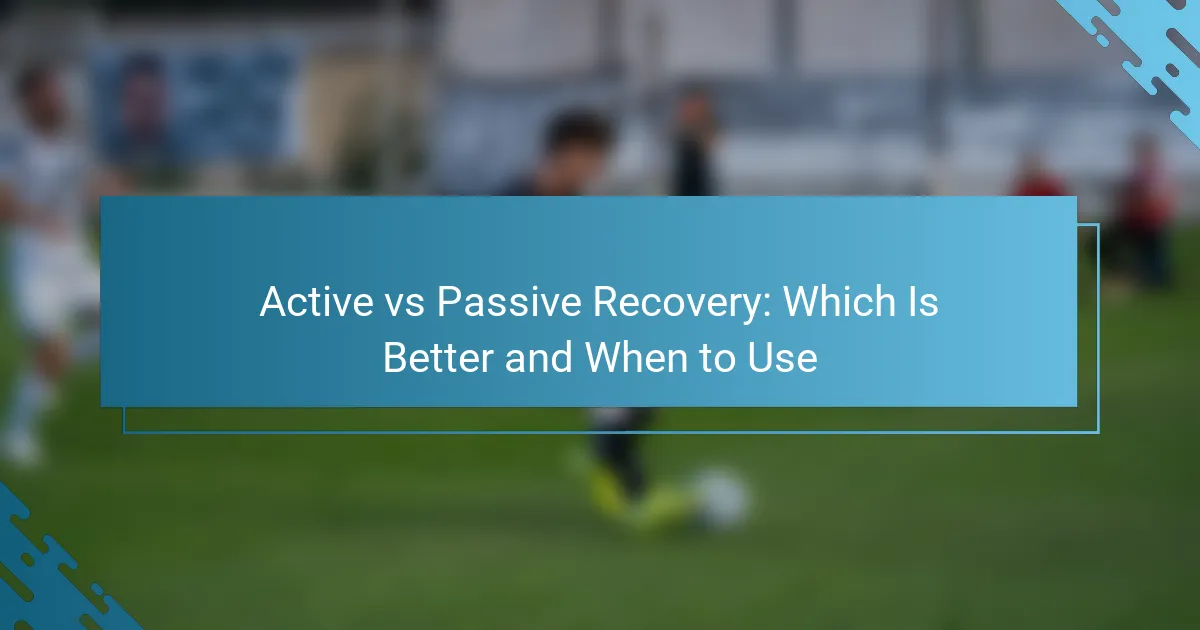Active and passive recovery are two distinct approaches to post-exercise recuperation, each with its own benefits. Active recovery involves engaging in low-intensity exercise to enhance blood flow and reduce muscle soreness, while passive recovery focuses on complete rest to allow the body to heal and restore energy levels. Understanding when to use each method can significantly impact overall recovery and performance.

What Is Active Recovery?
Active recovery refers to low-intensity exercise performed after strenuous activity to promote recovery and reduce muscle soreness. This approach contrasts with passive recovery, where no physical activity occurs, and is often favored for its potential benefits in maintaining blood flow and aiding in the recovery process.
Definition of active recovery
Active recovery is a method that involves engaging in light physical activity following intense workouts or competitions. The goal is to facilitate recovery by keeping the body moving without placing additional strain on fatigued muscles. This can include activities like walking, cycling at a leisurely pace, or gentle stretching.
Examples of active recovery methods
Common methods of active recovery include low-intensity activities such as walking, swimming, yoga, or cycling at a relaxed pace. These activities should be performed at a level that allows for conversation and does not lead to further fatigue. For instance, a 20-30 minute walk or a light swim can effectively promote recovery.
Benefits of active recovery
Active recovery can enhance blood circulation, which helps deliver nutrients to muscles and remove metabolic waste products. This process may reduce muscle soreness and stiffness, allowing for quicker recovery between workouts. Additionally, it can help maintain flexibility and range of motion, which are crucial for overall performance.
Who should use active recovery?
Active recovery is beneficial for athletes and individuals engaged in regular intense physical activity, such as runners, weightlifters, or team sports players. It is particularly useful for those who experience muscle soreness after workouts or those looking to improve their recovery times. However, anyone can incorporate active recovery into their routine, especially on rest days or after strenuous activities.

What Is Passive Recovery?
Passive recovery refers to a method of recuperation that involves minimal physical activity, allowing the body to heal and restore energy levels. This approach is often utilized after intense exercise or injury, focusing on rest and relaxation to promote recovery.
Definition of passive recovery
Passive recovery is characterized by a lack of physical exertion, allowing the body to recover naturally. It typically involves activities that do not require significant energy expenditure, such as resting, sleeping, or engaging in light, non-strenuous activities.
This type of recovery is essential for muscle repair and overall recovery, especially after high-intensity workouts or physical stress.
Examples of passive recovery methods
Common methods of passive recovery include taking complete rest days, using compression garments, receiving massages, and utilizing cryotherapy or heat therapy. Other examples are soaking in a warm bath or simply getting adequate sleep.
These methods help reduce muscle soreness and improve circulation, facilitating the body’s natural healing processes.
Benefits of passive recovery
Passive recovery can significantly reduce fatigue and muscle soreness, allowing for quicker recovery times. It helps restore energy levels, which is crucial for maintaining performance in subsequent workouts or activities.
Additionally, it can prevent overtraining and reduce the risk of injury by giving the body ample time to heal and adapt.
Who should use passive recovery?
Passive recovery is particularly beneficial for athletes recovering from intense training sessions or competitions, as well as individuals recovering from injuries. Those experiencing fatigue or muscle soreness after workouts should also consider incorporating passive recovery into their routine.
However, it is essential to balance passive recovery with active recovery methods to ensure optimal performance and health.

When Should You Use Active Recovery?
Active recovery is beneficial after intense workouts or competitions, helping to reduce muscle soreness and promote blood flow. It involves low-intensity activities that facilitate recovery without putting additional strain on the body.
Best scenarios for active recovery
Active recovery is ideal after high-intensity training sessions, endurance events, or heavy lifting days. It can also be useful during recovery weeks or when transitioning between workout phases. Engaging in light activities like walking, cycling, or swimming can enhance recovery while keeping the body moving.
Additionally, active recovery can help maintain fitness levels during injury rehabilitation or when returning from a break. It encourages mobility and flexibility, which are crucial for overall performance.
Duration and intensity recommendations
For effective active recovery, aim for sessions lasting between 20 to 60 minutes, depending on your fitness level and the intensity of previous workouts. Keep the intensity low, typically around 30-50% of your maximum effort, to ensure you’re not overexerting yourself.
Common activities include light jogging, yoga, or leisurely cycling. Monitor how your body feels during these sessions, and adjust the duration and intensity as needed to optimize recovery without causing fatigue.

When Should You Use Passive Recovery?
Passive recovery is best utilized when your body requires complete rest to heal and recuperate. This approach is ideal after intense workouts or injuries, allowing your muscles to recover without additional strain.
Best scenarios for passive recovery
Passive recovery is particularly beneficial after high-intensity training sessions, such as heavy weightlifting or sprinting, where muscle fatigue is significant. It’s also recommended during injury recovery, especially for strains or sprains, as it helps prevent further damage.
Additionally, if you experience fatigue or soreness that affects your performance, opting for passive recovery can facilitate healing. Situations like post-marathon recovery or during a deload week in a training cycle are prime examples where this method shines.
Duration and intensity recommendations
The duration of passive recovery can vary, typically ranging from a few days to a week, depending on your training intensity and individual recovery needs. For example, after a demanding workout, a rest period of 48-72 hours might be necessary before resuming strenuous activities.
Intensity during passive recovery should be minimal. Activities should focus on light stretching or gentle movements rather than any strenuous exercise. Listening to your body is crucial; if you still feel fatigued or sore, extending your recovery time is advisable.

How to Choose Between Active and Passive Recovery?
Choosing between active and passive recovery depends on your fitness goals, the intensity of your workouts, and how your body responds to stress. Active recovery involves low-intensity exercise to promote blood flow and reduce soreness, while passive recovery focuses on complete rest to allow for full recovery.
Key factors to consider
When deciding between active and passive recovery, consider the intensity of your previous workouts. If you’ve engaged in high-intensity training or heavy lifting, passive recovery may be more beneficial to allow your muscles to repair fully. Conversely, if your workouts were moderate, active recovery can help maintain blood circulation and speed up the healing process.
Another factor is your personal preference and how your body feels. Some individuals thrive on light activity, while others may find complete rest more rejuvenating. Pay attention to how you respond after different recovery methods to find what works best for you.
Comparison of effectiveness
Active recovery can be effective for reducing muscle soreness and stiffness, as it encourages blood flow and nutrient delivery to the muscles. Activities like walking, cycling at a low intensity, or yoga can be beneficial. Studies suggest that active recovery may lead to quicker recovery times compared to complete rest, especially after moderate exercise.
On the other hand, passive recovery is often more effective after intense workouts, where muscle damage is more significant. Complete rest allows the body to focus on repairing tissues without additional strain. A balanced approach, incorporating both methods based on workout intensity and personal preference, often yields the best results.

What Are the Risks of Each Recovery Type?
Both active and passive recovery methods carry specific risks that can affect overall performance and health. Understanding these risks is crucial for athletes and fitness enthusiasts to make informed decisions about their recovery strategies.
Potential risks of active recovery
Active recovery involves low-intensity exercise to promote blood flow and aid recovery, but it can lead to overexertion if not managed properly. Engaging in too much activity may result in fatigue or increased muscle soreness, counteracting the benefits of recovery.
Another risk is the potential for injury, especially if the active recovery activities are not suited to the individual’s fitness level. For example, someone recovering from a strenuous workout might attempt jogging when a gentle walk would be more appropriate.
To mitigate these risks, it’s essential to listen to your body and adjust the intensity of active recovery sessions accordingly. Aim for activities that feel comfortable and avoid pushing through pain or excessive fatigue.
Potential risks of passive recovery
Passive recovery, which involves complete rest, can lead to stiffness and decreased mobility if used excessively. While it allows for muscle repair, too much inactivity may hinder overall performance and prolong recovery time.
Additionally, relying solely on passive recovery can result in a loss of fitness, particularly for endurance athletes. Muscles may weaken without regular engagement, making it harder to return to previous performance levels.
To balance passive recovery, incorporate light stretching or mobility exercises to maintain flexibility and circulation. This approach can help prevent stiffness while still allowing the body to recover effectively.
